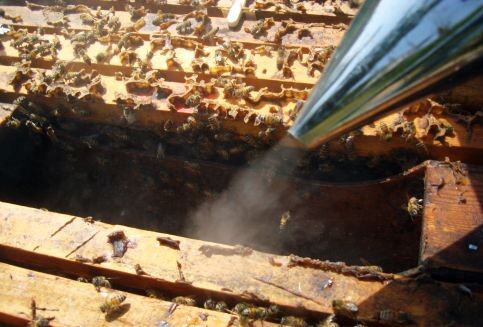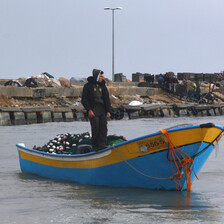The Electronic Intifada 19 July 2010

Bees too feel the impact of the Israeli assault. (Eva Bartlett/IPS)
GAZA CITY (IPS) - Sa’id Hillis, 60, has kept bees since he was a boy. Until the Israeli attacks changed his business.
Said has 20 dunams (a dunam is 1000 square meters) farmland in Shajaiyeh, east of Gaza City and roughly 400 meters from the Green Line boundary between the Gaza Strip and Israel. Until 2009 the farm had hundreds of trees, and more than 10,000 chickens. “It was all destroyed during the Israeli attacks,” Hillis says.
The winter 2008-09 23-day Israeli assault on Gaza destroyed more than 35 percent of Gaza’s agricultural land, according to the Food and Agriculture Organization (FAO). This included chicken and beef farms, and cultivated land.
Oxfam notes that the combination of the Israeli war on Gaza and maintaining of the buffer zone renders around 46 percent of agricultural land useless or unreachable. Since their means of living off the land was destroyed, Hillis’s family of 13 has survived off the income that Ramzi, Said’s oldest son, brings from driving a taxi.
“We had 250 boxes of bees, but they were bulldozed by the Israelis in 2004,” says Ramzi Hillis, 29, at his house, a kilometer from the boundary.
Walking behind the house, Hillis points out the remains of a family legacy. “After they were destroyed six years ago, we bought more bees and started over.” Until the war on Gaza, they had acquired 80 boxes of bees. “Fifteen boxloads of bees died during the bombing,” he says. “From phosphorous smoke.”
Box by box Hillis displays the surviving colony. “Each container should have at least eight slots,” he says. The slots are thin rectangular boards to which the bees weld their hives. But they are sparse and patchy. “They’re light this year, because of the effects of the bombings.”
The land from Hillis’s home to the line of trees on the Israeli side of the border is largely barren save wild scrub and the valiant attempts of Palestinian farmers to grow wheat under near-daily gunfire from Israeli soldiers.
“There used to be so many trees in this area, but they’ve all been bulldozed or bombed,” says Hillis. “The bees can still survive, but they have to work harder, fly farther, to find food.”
According to Hillis, the bees will fly as far as six kilometers in their search of nutrition.
After a winter of meagre natural sources and sugar water supplements, the honey quality is poor, and sells for around 70 shekels (17 dollars) per kilogram.
“The honey harvested in September sells for up to 116 shekels per kilo,” says Hillis, “because the bees spend the summer feeding off of flowers and fruit trees.”
Hassan Zaneen, 16, is learning the bee-keeping trade from his father Muhammad. The family has a small farm with bees, a handful of sheep and goats, and some sparse olive trees.
Hassan Zaneen takes precautions displaying the hives, donning full-body overalls and a screened head covering. Holding the long handle of a tin container, he lights the dried grass inside afire, waving the smoke at the boxes of bees.
“It calms the bees,” he explains, “keeps them from going into attack mode when we near their hives.”
The teen removes slot after slot, searching for the queen bee. Finally, he points out her golden form amidst the striped bodies of worker bees.
“She lives longer than the others, up to a year. They live around one month,” Zaneen explains. “During the spring, she lays around 1,500 eggs a day.”
Muhammad Zaneen explains that the bees’ lifespan is affected by the scarcity of food and hardships of life.
“We used to have over 10 dunams of olive trees. The bees thrived off of these. Their honey was strong and excellent quality. We brought in over $8,000 a year just in honey sales,” he says.
“But now we only have 18 trees, and the oldest are only four years. So the bees are fed with sugar water supplements, and they only produce honey once per year, not twice like they used to.”
They harvest their honey in April, but even before April there are small amounts of honey to sample. Zaneen digs into one honeycomb, bringing out thick, dark golden honey.
The best honey, Mohammed Zaneen and most Beit Hanoun residents agree, used to come from Beit Hanoun. Renowned for its lemon and orange trees, the northern region of Gaza was a haven for bees.
Mahdi Zaneen, 19, is from Beit Hanoun and lives two kilometers from the northern border.
“Our family has raised bees for over 30 years,” he says. “We had 500 boxes, but they were bulldozed in 2003 by the Israeli army.”
In 2010, the Zaneens tried to restart their bee colony. “They died, there’s no food for them now,” says Zaneen, gesturing to a landscape rendered devoid of trees.
Abdel Latif Dabous, has kept bees for a decade. “We’ve got 21 boxes now, but before the Israeli war on Gaza we had 75. Most died from the phosphorous shelling and loud noises of the bombing.
Jars of honey lining the windows of his shop in Rafah, Ahmed Zohrob has learned the trade from his father. And while he is an electrical engineer by profession, he prefers the honey business.
“Try this,” he says, sawing off a chunk of honey. “It’s light, with a hint of orange. In the autumn it will be darker, because the bees have feasted on flowers all summer.”
Some bee farmers, because of the reduced honey output, mix sugar with the honey. One kilo of mixed honey sells for roughly 50 shekels, but pure honey costs more than twice as much.
Barrels sit filled to the brim with the nectar Zohrob swears by. “It can be used to treat over one hundred afflictions,” he says.
But while the honey is quality, it will not leave Gaza, under siege since Hamas was elected in 2006, a siege tightened in mid-2007 to a degree that very little comes in and virtually nothing goes out.
“I love this business,” Zohrab says with a grin. “It’s sweet.”
All rights reserved, IPS — Inter Press Service (2010). Total or partial publication, retransmission or sale forbidden.





